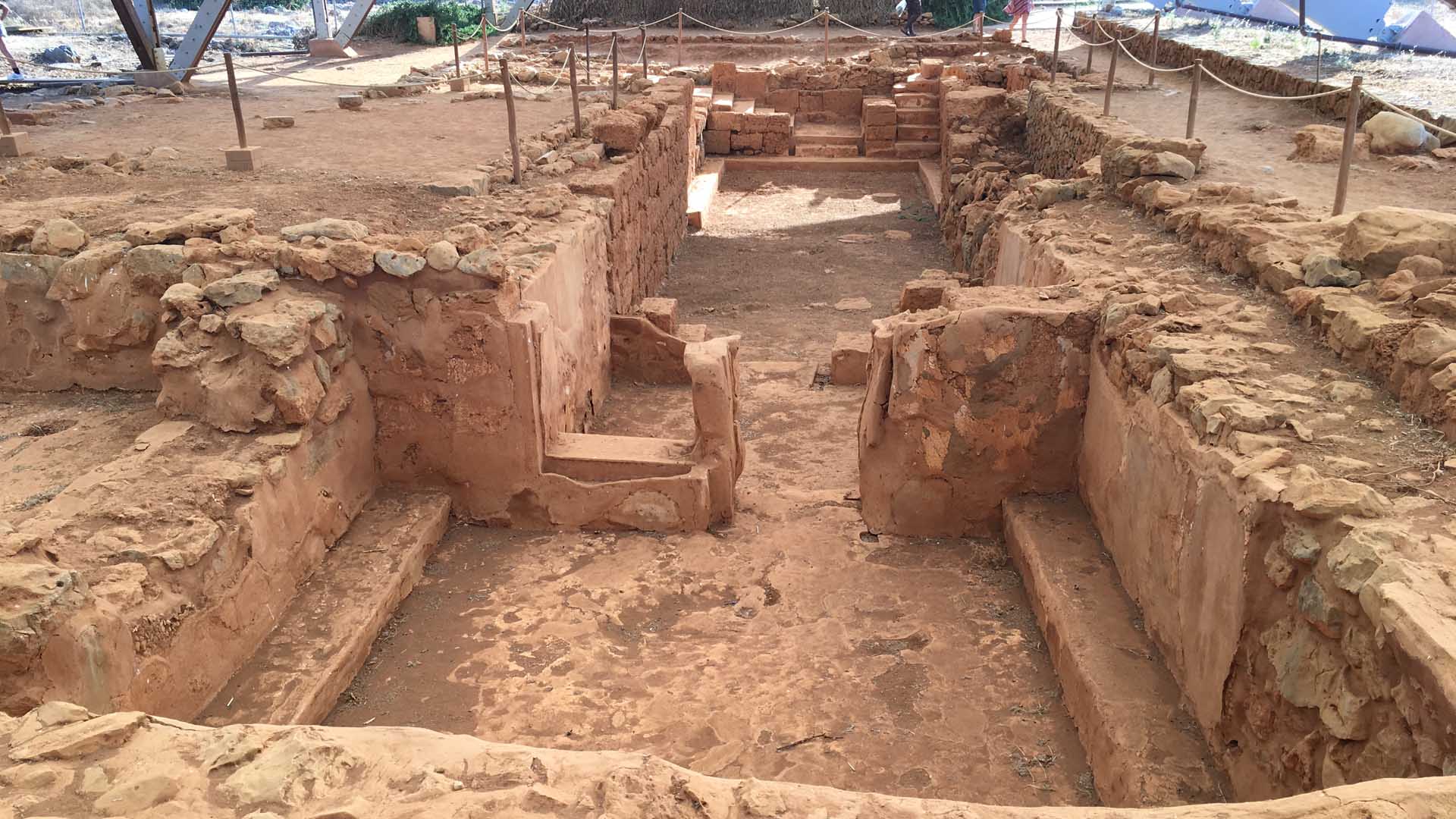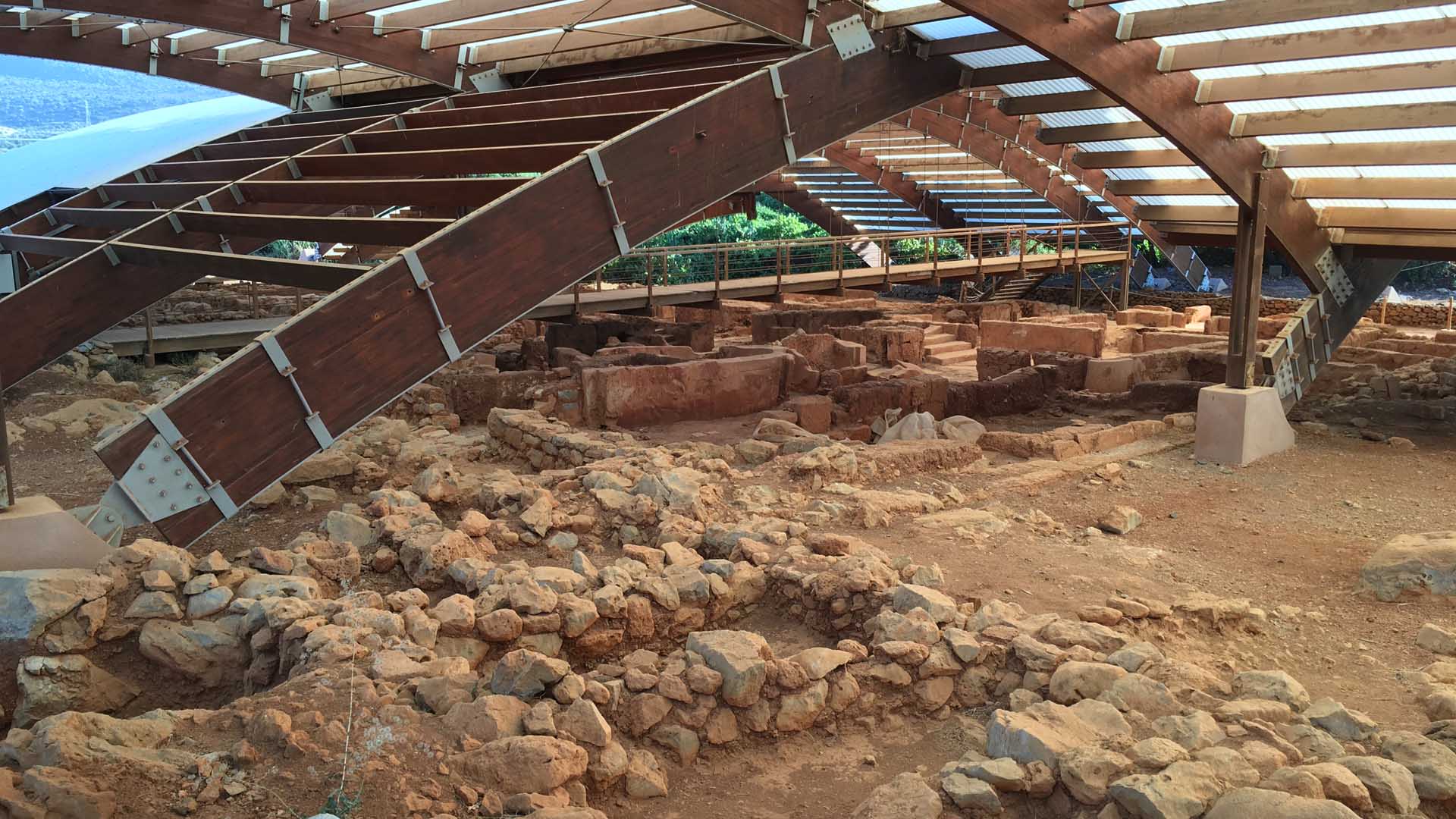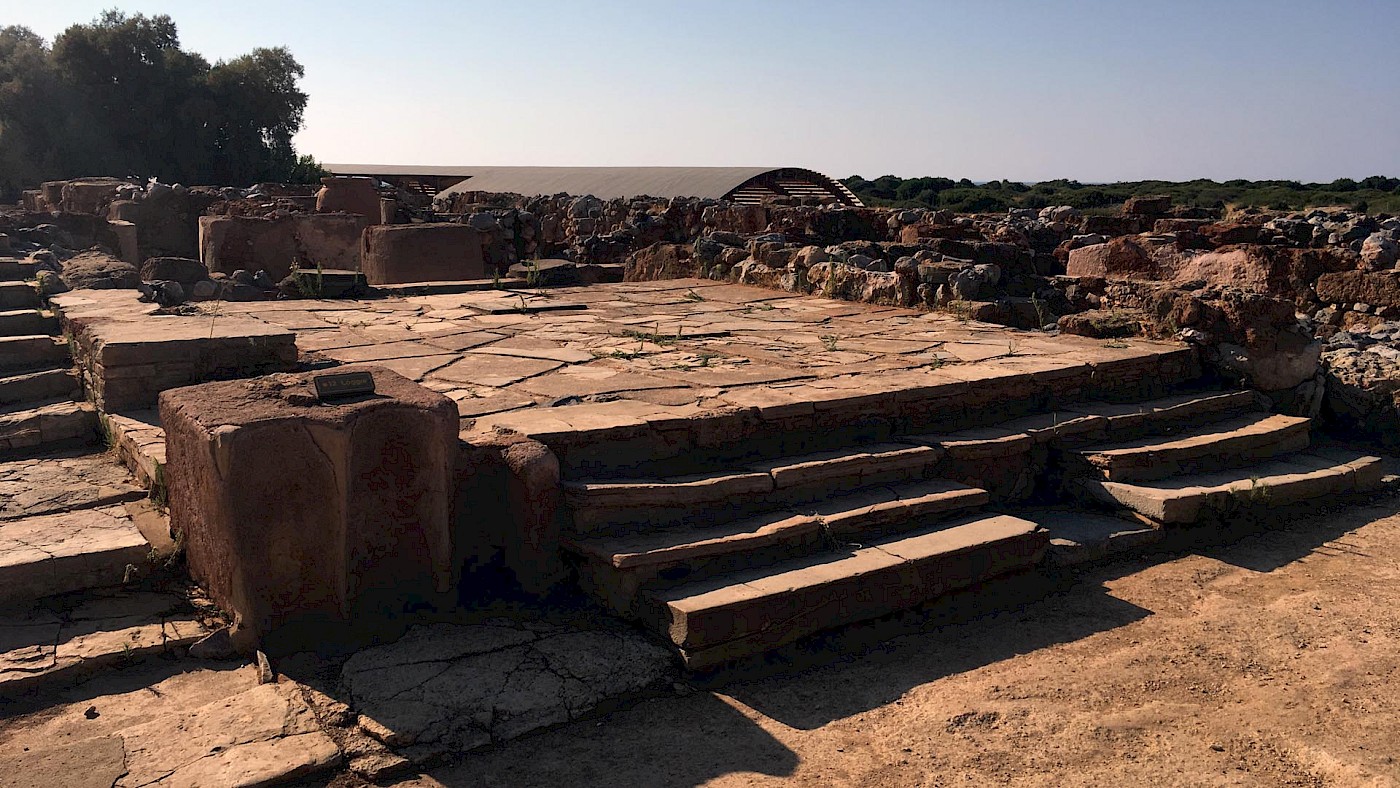Malia – also spelled with double L – is a seaside town along Crete’s northern coast, a little over 30 km east of Iraklion. Close to its sandy beach, a popular tourist haunt, is the sprawling archaeological site where remains of a “palace” and surrounding town have been unearthed by the French School, which has been digging here for about a century.
The ancient name for Malia is unknown. Unlike Knossos and Phaistos, the site was abandoned at the end of the Bronze Age, and no administrative documents have been recovered with the original name of the site. Based on documents from elsewhere, possible candidates for Malia’s ancient name include Setoija, as well as Milatos. There’s presently no way to know for sure if either of these names is correct.
The site has an old and slightly dilapitated visitor centre that goes into detail regarding the excavations at Malia, and also features models of the various buildings that have been unearthed. Unlike Knossos and Phaistos, the excavators at Malia have generally avoided naming structures or areas of the site, preferring instead to refer to them by more generic names in combination with Greek letters. Quartier Mu (“Area M”) is a good example of this, a complex of buildings to the northwest of the palace that is at present protected by a series of roofs.

Already during the Protopalatial period (ca. 1900-1700 BC), it’s clear that Malia was a place of regional importance. “Indeed,” as archaeologist Jan Driessen has asserted, “taking into account the score, scale, and quality of public or semiofficial buildings on the site, the case can be made that Malia had approached statelike status with a fully integrated settlement hierarchy of several levels” (2010, p. 561).
Much of what is presently visible on the site dates from the Middle Bronze Age, or the first half of the second millennium BC. The main parts of the archaeological site that are accessible to visitors include the Minoan palace, a large area to the northwest of it called the “Agora” (another court), the area around the so-called “Crypt” a little further to the west, and finally, even further away from the palace, “Quartier Mu”.
The palace at Malia is similar to that from other sites, with a few minor differences. The Central Court again follows the proportions and north-south orientation of e.g. Knossos, even if it’s a little smaller. A Hypostyle Hall, with square pillars, is located directly to the north of the court, and was probably used, as at Knossos, to receive people. In the centre of the court are the remains of a structure that may have been an altar of some kind. Off to the west is a raised platform that has been dubbed a “loggia” (depicted in this article’s featured image, above), and was probably a place of honour for people to observe rituals in the Central Court.

The “Agora” north of the palatial remains is another large court that some have suggested may have been used for bull games, but I’ve discussed earlier the difficulties in interpreting whether or not certain spaces were dedicated to bull games. The Agora is surrounded by a variety of buildings, presumably public (or semipublic) buildings and dwellings.
Perhaps the most intriguing part of the archaeological site at Malia is the so-called Hypostyle Crypt, a semi-underground structure with ashlar walls, that is accessible via a series of steps. The Crypt was constructed during the Middle Minoan II period, or the end of the Protopalatial phase, and re-used during the Neopalatial period, “at which time evidence for its earlier function was removed” (Driessen 2010, p. 563).
The Crypt features a polythyron, a so-called multiple doorway, also referred to as pier-and-door partitions, where one or more doors could be opened or closed to let in, or lock out, light and air. There is also a portico and a light-well, as well as a series of narrow rooms that resemble the magazines from the palaces – at Malia and elsewhere – that have therefore been interpreted as used for storage here, too.

The exact function of the Hypostyle Crypt is unknown. Since it’s located in the centre of the Minoan city, and based on analogy with later Greek cities, the excavators have suggested that it perhaps “served a town council” (McEnroe 2010, p. 63, with references).
The roofs protecting the archaeological remains of Quartier Mu are perhaps not the most aesthetically pleasing, but they offer valuable protection from the elements. This part of the site gives an excellent view of the extent of the excavations and the remains that have been unearthed of various structures; sadly, when we were there, the walkbridge that allows you to walk across the site was closed. Quartier Mu features two large buildings (A and B), each consisting of multiple rooms, covering approximately 2,000 sq. m.
Some of these rooms, as well as associated structures, are clearly workshops. In building A, the excavators have identified a “South Workshop” as well as a “Workshop C”. Building B housed the “Workshop of the Seals” as well as a “Potter’s Workshop”; an associated, but apparently freestanding structure, which has been labelled the “Founder’s Workshop”. However, other rooms were used as living space, for storage, and even for religious activities, making it clear that the “line between public and nonpublic gets fuzz[y]” here (McEnroe 2010, p. 64). The buildings also feature various other typically Minoan elements, including light-wells and, in Building A, a Lustral Basin.

With the destructions at the end of the Neopalatial period, ca. 1470/1460 BC, Malia was greatly diminished, with Knossos apparently the seat of a more centralized administration for the island as a whole. Knossian influence seems to diminish toward the end of the Late Bronze Age, around 1300 BC, when freestanding farmsteads appear at the site, rising from the ashes of the ruined palace. Destructions dated to the middle of the thirteen century BC (Late Minoan IIIB) appear to signal the end of long-term occupation at Malia.
Why was the site never occupied again? It’s quite possible that it was simply too vulnerable. Remains of what are perhaps fortification walls have been unearthed at the site, but it’s not clear if these wholly surrounded the settled area or were left unfinished. Following the unrest around 1200 BC, many people in Crete abandoned their settlements close to the coast and resettled further inland, often on higher, easily defensible ground (in general, see Nowicki 2000).
The archaeological site of Malia is well worth a visit. There’s ample parking on the site and there are busses from the modern town to the site, as well. It is also located a short distance from the beach, so that you can easily combine a visit to the archaeological site with a dip into the Aegean Sea, depending on the time of year!
Further reading
- Jan Driessen, “Malia”, in: Eric Cline (ed.), The Oxford Handbook of the Bronze Age Aegean (2010), pp. 556-570.
- John C. McEnroe, Architecture of Minoan Crete: Constructing Identity in the Aegean Bronze Age (2010).
- Krzysztof Nowicki, Defensible sites in Crete, c. 1200-800 BC: LM IIIB/IIIC through Early Geometric (2000).
